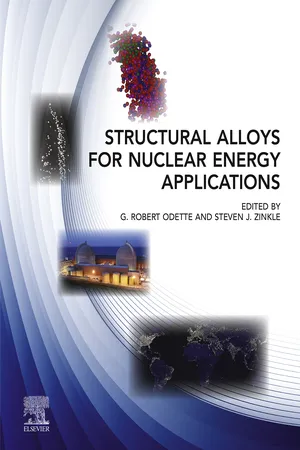
- 673 pages
- English
- ePUB (mobile friendly)
- Available on iOS & Android
Structural Alloys for Nuclear Energy Applications
About this book
High-performance alloys that can withstand operation in hazardous nuclear environments are critical to presentday in-service reactor support and maintenance and are foundational for reactor concepts of the future. With commercial nuclear energy vendors and operators facing the retirement of staff during the coming decades, much of the scholarly knowledge of nuclear materials pursuant to appropriate, impactful, and safe usage is at risk.Led by the multi-award winning editorial team of G. Robert Odette (UCSB) and Steven J. Zinkle (UTK/ORNL) and with contributions from leaders of each alloy discipline, Structural Alloys for Nuclear Energy Applications aids the next generation of researchers and industry staff developing and maintaining steels, nickel-base alloys, zirconium alloys, and other structural alloys in nuclear energy applications. This authoritative reference is a critical acquisition for institutions and individuals seeking state-of-the-art knowledge aided by the editors' unique personal insight from decades of frontline research, engineering and management.- Focuses on in-service irradiation, thermal, mechanical, and chemical performance capabilities.- Covers the use of steels and other structural alloys in current fission technology, leading edge Generation-IV fission reactors, and future fusion power reactors.- Provides a critical and comprehensive review of the state-of-the-art experimental knowledge base of reactor materials, for applications ranging from engineering safety and lifetime assessments to supporting the development of advanced computational models.
Frequently asked questions
- Essential is ideal for learners and professionals who enjoy exploring a wide range of subjects. Access the Essential Library with 800,000+ trusted titles and best-sellers across business, personal growth, and the humanities. Includes unlimited reading time and Standard Read Aloud voice.
- Complete: Perfect for advanced learners and researchers needing full, unrestricted access. Unlock 1.4M+ books across hundreds of subjects, including academic and specialized titles. The Complete Plan also includes advanced features like Premium Read Aloud and Research Assistant.
Please note we cannot support devices running on iOS 13 and Android 7 or earlier. Learn more about using the app.
Information
Overview of Structural Materials in Water-Cooled Fission Reactors
Abstract
Keywords
1.1 Introduction

| As of April 2017 | 2016 | |||
|---|---|---|---|---|
| Country | Number of Nuclear Units | Nuclear Capacity (MW) | Nuclear Generation (GWh) | Nuclear Fuel Share (%) |
| Argentina | 3 | 1632 | 7677.4 | 5.6 |
| Armenia | 1 | 375 | 2194.9 | 31.4 |
| Belgium | 7 | 5913 | 41,430.5 | 51.7 |
| Brazil | 2 | 1884 | 14,970.5 | 2.9 |
| Bulgaria | 2 | 1926 | 15,083.5 | 35.0 |
| Canada | 19 | 13,554 | 95,650.2 | 15.6 |
| China | 36 | 31,384 | 197,829.0 | 3.6 |
| Czech Republic | 6 | 3930 | 22,729.9 | 29.4 |
| Finland | 4 | 2764 | 22,280.1 | 33.7 |
| France | 58 | 63,130 | 386,452.9 | 72.3 |
| Germany | 8 | 10,799 | 80,069.6 | 13.1 |
| Hungary | 4 | 1889 | 15,183.0 | 51.3 |
| India | 22 | 6240 | 35,006.8 | 3.4 |
| Iran, Islamic Republic of | 1 | 915 | 5924.0 | 2.1 |
| Japan | 43 | 40,290 | 17,537.1 | 2.2 |
| Korea, Republic of | 25 | 23,077 | 154,306.7 | 30.3 |
| Mexico | 2 | 1552 | 10,272.3 | 6.2 |
| Netherlands | 1 | 482 | 3749.8 | 3.4 |
| Pakistan | 4 | 1005 | 5438.9 | 4.4 |
| Romania | 2 | 1300 | 10,388.2 | 17.1 |
| Russia | 37 | 26,528 | 184,054.1 | 17.1 |
| Slovakia | 4 | 1814 | 13,733.4 | 54.1 |
| Slovenia | 1 | 688 | 5431.3 | 35.2 |
| South Africa | 2 | 1860 | 15,209.5 | 6.6 |
| Spain | 7 | 7121 | 56,102.4 | 21.4 |
| Sweden | 10 | 9740 | 60,647.4 | 40.0 |
| Switzerland | 5 | 3333 | 20,303.1 | 34.4 |
| Taiwan, China | 6 | 5052 | 30,461.0 | 13.7 |
| United Kingdom | 15 | 8918 | 65,149.0... | |
Table of contents
- Cover image
- Title page
- Table of Contents
- Copyright
- Contributors
- Preface
- Chapter 1: Overview of Structural Materials in Water-Cooled Fission Reactors
- Chapter 2: Overview of Reactor Systems and Operational Environments for Structural Materials in Gen-IV Fission Reactors
- Chapter 3: Overview of Reactor Systems and Operational Environments for Structural Materials in Fusion Reactors
- Chapter 4: Research Tools: Microstructure, Mechanical Properties, and Computational Thermodynamics
- Chapter 5: Radiation and Thermomechanical Degradation Effects in Reactor Structural Alloys
- Chapter 6: Corrosion Issues in Current and Next-Generation Nuclear Reactors
- Chapter 7: Zirconium Alloys for LWR Fuel Cladding and Core Internals
- Chapter 8: Austenitic Stainless Steels
- Chapter 9: Ni-Based Alloys for Reactor Internals and Steam Generator Applications
- Chapter 10: Low-Alloy Steels
- Chapter 11: Ferritic and Tempered Martensitic Steels
- Chapter 12: Nano-Oxide Dispersion-Strengthened Steels
- Chapter 13: Refractory Alloys: Vanadium, Niobium, Molybdenum, Tungsten
- Index